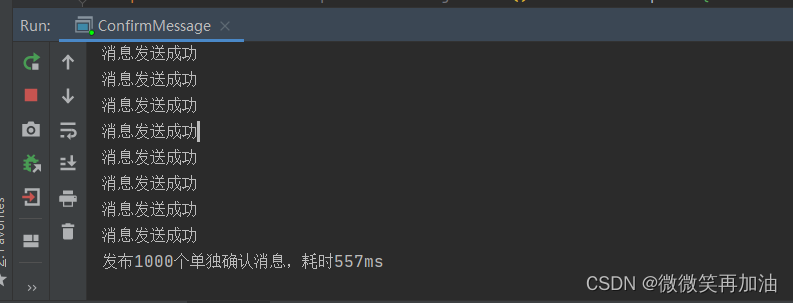保证消息不丢失,除了队列开启持久化,消息开启持久化之后,还要发布确认才能完全保证消息不丢失
发布确认有三种
1.单个确认发布
一种同步确认发布的方式,也就是发一个消息以后只有他被确认发布,后续的才能继续发布。最大的缺点是:发布速度特别慢
//单个确认
public static void publishMessageSingle() throws Exception{
Channel channel = Util.getChannel();
//队列的声明
String queueName = UUID.randomUUID().toString();
channel.queueDeclare(queueName,true,false,false,null);
//开启发布确认
channel.confirmSelect();
//开始时间
long begin = System.currentTimeMillis();
//批量发消息
for (int i = 0; i < MESSAGE_COUNT; i++) {
String message = i + "";
channel.basicPublish("",queueName,null,message.getBytes());
//单个消息就马上发布确认
boolean flag = channel.waitForConfirms();
if(flag){
System.out.println("消息发送成功");
}
}
//结束时间
long end = System.currentTimeMillis();
System.out.println("发布"+MESSAGE_COUNT+"个单独确认消息,耗时"+(end-begin)+"ms");
}
结果如下:耗时557ms

2.批量确认发布
与单个等待确认消息相比,先发布一批消息然后一起确认可以极大地提高吞吐量,当然这种方式的缺点就是:当发生故障导致发布出现问题时,不知道是哪个消息出现问题了,我们必须将整个批处理保存在内存中,以记录重要的信息而后重新发布消息。当然这种方案仍然是同步的,也一样阻塞消息的发布。
//批量确认
public static void publishMessageBatch() throws Exception{
Channel channel = Util.getChannel();
//队列的声明
String queueName = UUID.randomUUID().toString();
channel.queueDeclare(queueName,true,false,false,null);
//开启发布确认
channel.confirmSelect();
//批量确认消息大小
int batchSize = 100;
//开始时间
long begin = System.currentTimeMillis();
//批量发消息 批量发布确认
for (int i = 0; i < MESSAGE_COUNT; i++) {
String message = i + "";
channel.basicPublish("",queueName,null,message.getBytes());
//每达到100次,批量发布确认一次
if(i%batchSize == 0){
//发布确认
channel.waitForConfirms();
}
}
//结束时间
long end = System.currentTimeMillis();
System.out.println("发布"+MESSAGE_COUNT+"个批量确认消息,耗时"+(end-begin)+"ms");
}
结果如下:耗时274ms

3.异步确认发布
异步确认虽然编程逻辑比上两个要复杂,但是性价比最高,无论是可靠性还是效率都没得说,他是利用回调函数来达到消息可靠性传递的,这个中间件也是通过函数回调来保证是否投递成功。
//异步发布确认
public static void publishMessageAsync() throws Exception{
Channel channel = Util.getChannel();
//队列的声明
String queueName = UUID.randomUUID().toString();
channel.queueDeclare(queueName,true,false,false,null);
//开启发布确认
channel.confirmSelect();
//开始时间
long begin = System.currentTimeMillis();
/**
* deliveryTag:消息的标记
* multiple:是否批量确认
*/
//消息确认成功 回调函数
ConfirmCallback ackCallback = (deliveryTag,multiple)->{
System.out.println("确确认消息"+deliveryTag);
};
//消息确认失败 回调函数
ConfirmCallback nackCallback = (deliveryTag,multiple)->{
System.out.println("未确认消息"+deliveryTag);
};
//准备消息监听器 监听那些消息成功,那些消息失败
/**
* 1.监听成功方法
* 2.监听失败方法
*/
channel.addConfirmListener(ackCallback,nackCallback);//异步通知
//批量发送消息
for (int i = 0; i < MESSAGE_COUNT; i++) {
String message = i + "";
channel.basicPublish("",queueName,null,message.getBytes());
}
//结束时间
long end = System.currentTimeMillis();
System.out.println("发布"+MESSAGE_COUNT+"个异步发布确认消息,耗时"+(end-begin)+"ms");
}
结果如下:耗时21ms

要如何处理未发布确认的消息,需要在异步处理的情况下增加下面四步:(1)(2)(3)(4)步骤标注如下
//异步发布确认
public static void publishMessageAsync() throws Exception{
Channel channel = Util.getChannel();
//队列的声明
String queueName = UUID.randomUUID().toString();
channel.queueDeclare(queueName,true,false,false,null);
//开启发布确认
channel.confirmSelect();
/**
* (1)
* 线程安全有序的一个哈希表,适用于高并发的情况下
* 1.将序号与消息进行关联
* 2.批量删除条目 只要给到序号
* 3.支持高并发(多线程)
*/
ConcurrentSkipListMap<Long,String> outsConfirms = new ConcurrentSkipListMap<>();
//开始时间
long begin = System.currentTimeMillis();
/**
* deliveryTag:消息的标记
* multiple:是否批量确认
*/
//消息确认成功 回调函数
ConfirmCallback ackCallback = (deliveryTag,multiple)->{
//(3)删除到已经确认的消息,剩下的就是未确认的消息
if(multiple){//批量确认 很少用要保证消息不丢失
ConcurrentNavigableMap<Long, String> longStringConcurrentNavigableMap =
outsConfirms.headMap(deliveryTag);
longStringConcurrentNavigableMap.clear();
}else {//单个确认
outsConfirms.remove(deliveryTag);
}
System.out.println("已确认消息"+deliveryTag);
};
//消息确认失败 回调函数
ConfirmCallback nackCallback = (deliveryTag,multiple)->{
//(4)处理打印未确认的消息
String message = outsConfirms.get(deliveryTag);
System.out.println("未确认消息"+deliveryTag+":"+message);
};
//准备消息监听器 监听那些消息成功,那些消息失败
/**
* 1.监听成功
* 2.监听失败
*/
channel.addConfirmListener(ackCallback,nackCallback);//异步通知
//批量发送消息
for (int i = 0; i < MESSAGE_COUNT; i++) {
String message = i + "";
channel.basicPublish("",queueName,null,message.getBytes());
//(2)此处要记录发送的消息
outsConfirms.put(channel.getNextPublishSeqNo(),message);
}
//结束时间
long end = System.currentTimeMillis();
System.out.println("发布"+MESSAGE_COUNT+"个异步发布确认消息,耗时"+(end-begin)+"ms");
}
最后
以上就是鲤鱼小刺猬最近收集整理的关于RabbitMq之发布确认的全部内容,更多相关RabbitMq之发布确认内容请搜索靠谱客的其他文章。
本图文内容来源于网友提供,作为学习参考使用,或来自网络收集整理,版权属于原作者所有。








发表评论 取消回复